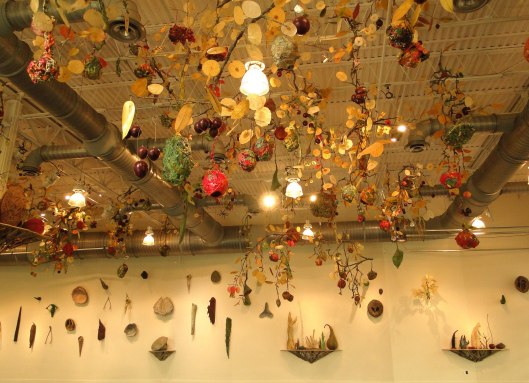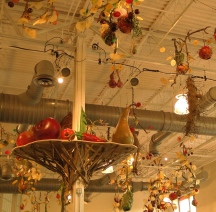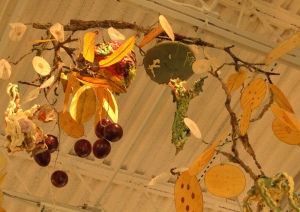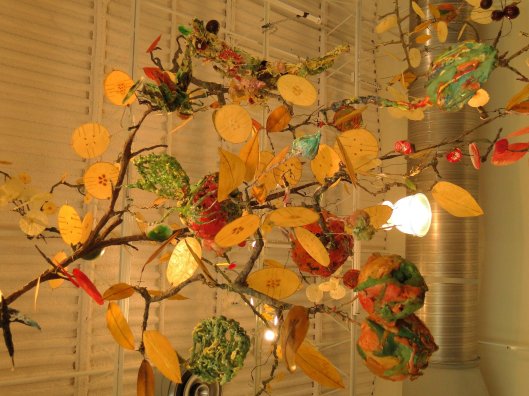Thirty Years of Cultivation: Ming Fay’s Canutopia
Views on Art Blog
Grace Hsu, Volunteer Docent at Grounds For Sculpture
July 10, 2012
Thirty Years of Cultivation: Ming Fay’s Canutopia
10 Tuesday Jul 2012
By Grace Hsu, Volunteer Docent at Grounds For Sculpture
In the expansive 10,000 square foot East Gallery, enormous fruits, vegetables, and seed pods are mingled with plants, bones, seashells, spirals. Strange objects sit on shelves and ledges, hang on walls, and dangle from the two-story high ceiling. It is Ming Fay’s complex and harmonious garden Canutopia, which he cultivated through more than thirty years of his career. It is a refreshing and tranquil place for people to escape from the hectic urban life.
Fay was born in Shanghai, China and grew up in Hong Kong. His fruits bear Chinese auspicious wishes and cultural symbols; pears for prosperity, peaches for longevity, oranges for good luck, and cherries for love. There are also hairy ginseng roots for elixirs. The grand proportions of Fay’s surrealistic fruits, vegetables, and seeds possess power and a sense of Taoist philosophy which considers human beings part of nature and coexisting in harmony with nature. To further invert the Western notion of human importance, Fay’s root-man on the shelf and the figurines hanging in the air are almost invisible in his garden.
Beyond enlarging natural forms, Fay has invented hybrids. They look real, but do not represent any specific species, and contain mixed meanings. The bat-like Chinese water lily nut, ling-jiao, on the wall above one of the entrances symbolizes inspiration or spirituality. Its various shapes hint at the idea of genetic alterations.
The desire for wealth seems universal among people in different cultures. Based on the silver dollar plant and the Chinese money tree, Fay constructed twigs and vines with flourishing, translucent round leaves. The natural shade and golden round leaves are imbedded with chamomile seeds which are believed to have curative power. Monkey pot is a pot shaped and wood colored fruit originally from the Amazon. Monkeys often get their heads stuck when they try to obtain the tasty nuts inside. As a metaphor for getting caught up in our desires, Fay’s transformed monkey pots are colorful, bold, and weird.
On his long voyage from Hong Kong to the US in 1961, and as a participant in the ‘University on the Sea’ in the early 1980s, Fay was fascinated by the inherent geometric sense of order, proportion, and aesthetics of seashells. The symmetry of some seashells displays overt sexuality and refers to reproduction and the life cycle. Inspired by this, he created the seashells and spirals series.
While cruising around the world in the early 1980s, the newly married Fay made a wishbone sculpture on the ship using a clothes hanger and paper and made a wish to have a child. His wish came true; it brought him a son. On his many travels, Fay collected bones and unusual natural forms. The mystery of the life cycle and the process of extinction also became sources of inspiration. The skulls represent mortality and the link between modern men and their ancestors. The assemblage of bones expresses Fay’s contemplation of prehistoric life forms.
The mixed media wire, gauze, plaster, paper pulp, urethane foam, and paint, which were used by Fay to construct his Canutopia, are common and manmade materials. But the themes of Fay’s garden are about nature, life, and the wellbeing of mankind from the prehistoric age to the present, and possibly to a science fiction-like future.




